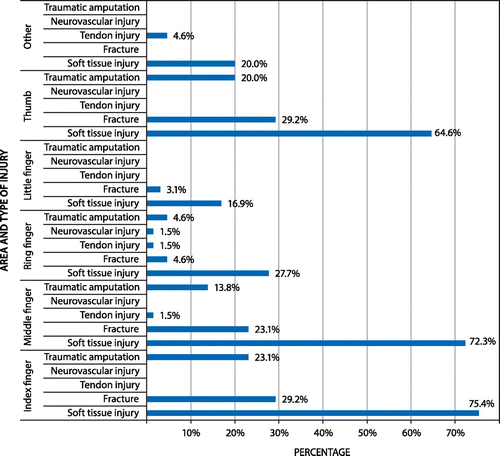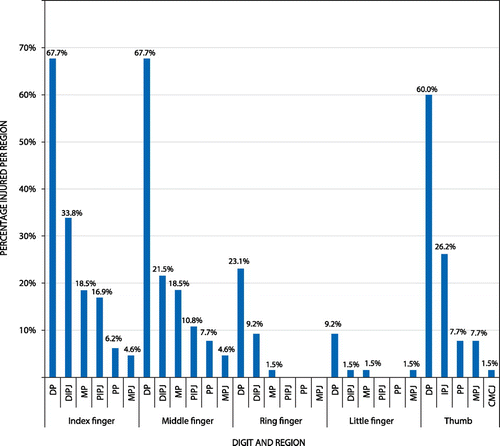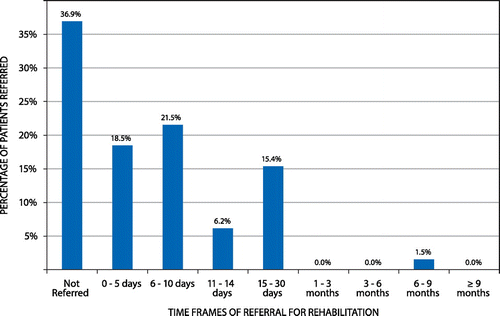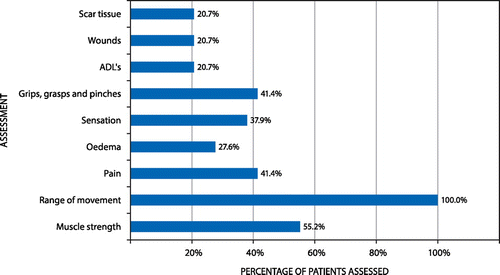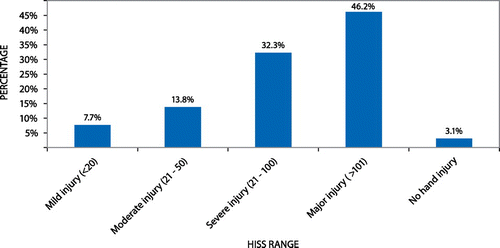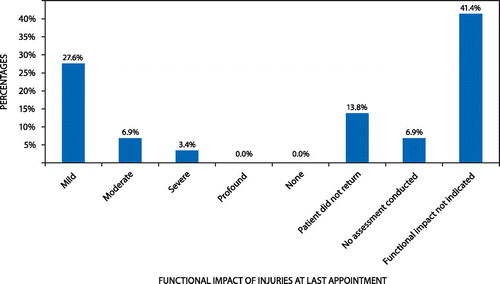Abstract
Background: Numerous studies internationally highlight the devastating effects of firework-related injuries and the costs involved in treating these injuries, in addition to the calls to alter legislation to prevent these injuries from occurring. There has, however, been a paucity of research studies in the South African context that describes the complexity of the injuries sustained. The aim of this study was thus to profile the firework-injured hand and to review the management from a surgical and rehabilitation perspective.
Methods: A retrospective file audit was conducted on patients who had sustained firework injuries between 2009 and 2014 (n = 65) in two hospitals in KwaZulu-Natal (KZN), South Africa.
Results: The firework-injured hand has a varied profile, which appears to be dependent on the blast capacity. The thumb, index and middle fingers were predominantly affected at the level of the distal phalanges and distal interphalangeal joints resulting in amputation due to severe soft tissue injury and resultant fractures. Hand Injury Severity Scores indicated a large percentage of cases within the severe category. Medical and surgical interventions occurred within the first three to six hours post-injury and involved washout, cleaning, debridement and suturing. Formalisation of amputation was the predominant course of action. Rehabilitation was focused on assessment and hand therapy to ensure functional outcomes.
Conclusions: From this study, the authors conclude that the firework-injured hand should be managed according to the resultant diagnosis, be it an amputation, fracture, or soft tissue injury, whilst managing the symptoms of oedema, pain and stiffness, which will all impact on hand function outcomes.
Introduction
Fireworks are a sight to behold when displayed safely and correctly, but, as the name suggests, are dangerous. When used by untrained persons and children, fireworks are especially dangerous, having the capacity to explode unexpectedly. The injury caused by a firework exploding while being held can have a devastating effect on the functional status of the hand. The human hand is described as the most developed prehensile organ among all living creatures.Citation1 Preservation of hand function is thus of utmost importance following a firework injury. Function is defined as the manner in which the human hand is able to perform (assume, use, maintain and release) the necessary grips and grasps in a range of activities for task completion against a sensory background.Citation1
Types of firework injuries to the hand
The injuries that occur in a firework-injured hand include soft tissue injuries, fractures, burns and traumatic amputations in addition to disruption of the neurovascular supply.Citation2,3 Ground-spinners, sparklers and flares have wicks that are lit, and are the primary culprits of burns and soft tissue injuries. String-bombs and rockets cause blast injuries that result in fracture(s), amputation(s) and disruption of the hand’s neurovascular supply.Citation4–6 Soft tissue injuries are injuries that cause abrasion and lacerations that affect the skin and underlying fascia. These tissues are essential in covering the underlying blood supply, nerves, muscles and tendon, ligaments, bones and joints. The skin as an organ in its own right is essential for successful hand function as pliable skin allows for tendons to glide under the skin, it stretches over joints to allow for movement and is essential for tactile functions of the hand. Any soft tissue injury with resulting scar tissue, if left untreated, can have a significant negative impact on hand function by limiting the amount of pliability and elasticity, and reducing the range of movement. Fractures occur when the vibration of the blast component causes the phalanges to break while the distal volar plates of the interphalangeal joints (IPJs) give way, which results in dislocations and avulsion fractures of the IPJs.Citation7,8 In most cases, these joints undergo amputation. In cases where the joint undergoes repair or reconstruction, the complications include infection, stiffness from long-term immobilisation and pain. The stiff and fixed joint has a direct implication on the ability of the patient to assume a specific grip or pinch. Traumatic amputation occurs when the soft tissues, bones, tendons and ligaments are unable to withstand the explosive force of the firecracker, resulting in a shattering of bone, disruption of the joint, and irreparable damage to the blood vessels and digital nerves as well as insufficient skin coverage. It is common that the patient presents with denuding and de-gloving injuries of the fingers with exposed bone. In these cases, the patient undergoes formalisation of amputation to ensure that there is sufficient skin and soft tissue coverage and the exposed bone is trimmed. It is imperative for the surgeon to ensure adequate soft tissue coverage so as to prevent neuromas, which cause hypersensitivity in the stump and render the stump useless.
Medical and surgical interventions for firework injuries to the hand
WilsonCitation9 highlighted a number of risk factors related to the use of fireworks that resulted in injuries to the hand. These included the relighting of an unexploded firework, holding the firework in the hand that explodes and the firework being thrown at a passer-by.Citation9 Lighting gunpowder on the ground, a lack of adult supervision, placing of a lit firework placed in metal or glass container and the malfunction of fireworks are further examples of risk factors that result in firework-related injuries.Citation9
It has been suggested that blast injuries to the hand require an immediate and strategically planned surgical approach.Citation3 In their study, Giessler and colleaguesCitation3 found that the most frequent injuries sustained were partial thickness burns, lacerations, dislocations, amputation of fingers and fractures. Emergency surgical interventionCitation3,9 is undertaken depending on the severity of the injury according to the doctors’ assessment; in some cases surgery is completed a few hours later. Surgical interventionsCitation3,9,10 comprise debridement and washout, ensuring sufficient skin coverage and formalisation of amputation. Reconstruction was not seen as the primary objective in many cases, i.e. for tendon, bony and neurovascular repair, flap cover or amputation. Superficial burns are treated with dressings. Some wounds require only thorough cleaning and primary suturing. In the more severe cases, the injuries are described as mutilating, mangled and crushed. These injuries have the most devastating effect on long-term hand function as they result in proximal amputations.Citation11 The more proximal the amputation of the thumb, index and middle fingers, the greater the impact on hand function, specifically prehension, as the patient would be unable to assume the most basic of pinches, grips and grasps.
Lengthy waiting times also have direct implications on the firework-injured hand as devitalised tissues require further debridement or amputation. Preservation of finger length and function is thus compromised for reconstructionCitation12 with potential complications such as compartment syndromeCitation13 and infectionCitation14 that may ensue.
Hand rehabilitation for firework injuries
The hand therapist is seen as a key player in the functional rehabilitation of the injured hand, and the earlier the rehabilitation commences, the better the outcome.Citation15–17 Rehabilitation in itself is tailor-made to address the resultant impairments after injury and the treatment programme is determined once assessment has been completed. Thus, a patient-directed rehabilitation programme within an accepted clinical protocol is expected. A current trend in the literature reflected that the fireworkinjured hand is addressed as a severely injured hand,Citation1 and while this is not a standardised treatment protocol specific to firework injuries, it does take into account the different healing times of the affected tissues.
Given the limited literature on how to manage hand injuries following a firework incident due to complexity of the injury, the authors attempted to profile the firework-injured hand with a review of surgical and rehabilitation management as an initial step. There may be the potential for the development of a clinical protocol for management once the profile of such injuries is known.
Material and methods
Design and sampling
A retrospective file audit of medical records of patients from two hospitals in KwaZulu-Natal, South Africa was undertaken via purposive sampling. These hospitals were selected based on the presence of on-site trauma units as well as specialised orthopaedic units, and occupational therapy and physiotherapy departments, which are involved in the management of the firework-injured hand. The sample included clients who were diagnosed with a firework injury who met specific selection criteria, namely a diagnosis of a firework injury, where the mechanism of injury or diagnosis referred to included “firecracker” “firework” or “hand injury due to fireworks”.
The audit covered a five-year time frame (2009–2014), specifically from 30 December to January 5 of each year. A total of 65 records were eligible for inclusion. A file audit was unobtrusive and was well suited for trend analysis in the profiling process of a firework injury to the hand. Whilst some authors are of the opinion that retrospective file audits have many limitations due to inconsistent record keeping by clinicians (therapists, doctors, nurses),Citation18 there is a positive opinion that there is a wealth of untapped information in historical records for research purposes; however, ethical considerations of the information still apply.Citation19,20 Thus ethical clearance was obtained from two ethical structures, namely the Biomedical Research Ethics Committee situated at a higher education institution and the Provincial Department of Health Research and Knowledge Management sub-component.
Data extraction survey
The authors extracted data on a survey form for each medical record. The data extraction tool was organised across the following information categories: facility information, patient demographics (age, gender, vocation), and handedness (dominance and hand injured). A perusal of the literature assisted in identifying the possible types of injuries and surgical interventions. Injuries were further categorised according to area of hand injured and type of injury sustained. Time variables included date and time of injury, time to treatment of injuries, length of in-patient stay, length of time taken to refer the patient for rehabilitation, and amount of time spent in the rehabilitation programme. Functional assessment completed on discharge and the level of functional impairment at discharge were also extracted. Finally an individual Hand Injury Severity Score was also obtained for each case.
Pilot study
A pilot study was administered, the findings of which strengthened the data extraction tool by including categories of levels of injury (via the HISS Scoring System — described later in this paper), which was found to be easily reproduced and user friendly, as well as in the recording of rehabilitation assessments and rehabilitation interventions. Moreover, time allocations for data extraction were set at 20–30 min per file following the pilot study.
Data analysis
The data were coded and analysed using SPSS version 21™ (IBM Corp, Armonk, NY, USA) and Windows Excel 7™ (Microsoft Corp, Redmond, WA, USA). Descriptive statistics (frequencies and counts) are used to describe the findings.
Results and discussion
A total of 65 case files were accessed, which reported incidents of firework-related hand injuries over a five-day period (December 30 to January 5) over a five-year period, i.e. 65 cases over 25 days. All cases presented at the Casualty or Trauma departments prior to being referred for orthopaedic consultation.
Gender distribution
Mean age was 31 years; 70.8% of patients were male as compared with 29.2% who were female. This is in keeping with other studies.Citation7,8,14,21 This perhaps reflects that more males engage in firework use as a recreational activity.
Age and vocations of patients
The ages of the patients in this study reflected the highest number of injured individuals within the workforce age bracket of 30–39 years (32.3%), 19–29 years (21.5%) and 40–49 years (20%). The direct impact on occupation cannot be underestimated; however, in this study in 55.4% of cases the occupation was not indicated or recorded. For the cases that indicated the patient’s vocation, 20% were either a student or scholar, 6.2% were unemployed, 6.2% were employed as drivers and 6.2% were involved in manual labour. The remaining patients were either gainfully employed in office-based employment (3.1%) and professional or skilled employment (1.5%), or in receipt of a pension (1.5%).
Dominance versus injured hand
Hand dominance in 63.1% of cases was not recorded. Additionally, 13.8% of the case reports did not indicate which hand was affected. Right-handedness was recorded in 29.2% of cases and left-handedness in 7.75% of cases. The right hand was more frequently injured (61.5%) as compared with the left (24.6%). In a study by Adhikari et al.,Citation8 82% of injuries sustained by their sample occurred in the dominant hand. The patho-mechanismCitation13 of the blast injury was explained as follows: the person holds the firework in the dominant hand after lighting it in order to place or throw it and hence sustains more injuries to the dominant hand. An injury to the dominant hand poses immediate functional implications for fine motor functions such as writing, buttoning and unbuttoning, picking up coins or applying cosmetics, as well as bilateral hand functions such as tying laces or food preparation.
The implications of not knowing the patient’s occupation and hand dominance have a direct impact on surgical decision-making, namely level of amputationCitation13 or reconstruction. Knowledge of the patient’s occupation and hand dominance has a greater impact on the treating therapist/clinician as the patient’s occupation will determine the treatment plan, time frames and treatment modalities to be used in rehabilitation, i.e. the therapist has to match the rehabilitation activities to the patient’s occupational areas of work, domestic, leisure and ADLs; second, the patient’s hand dominance, diagnosis and aim of treatment will affect the type of activity, and the structuring of the treatment activity and area, i.e. placement of equipment, tools and materials.
Type of injuries sustained
Figure highlights the type of injury sustained per digit. The thumb, index and middle fingers sustained the greatest trauma, comprising mainly soft tissue injuries, i.e. thumb (64.6%), index finger (75.4%) and middle finger (72.3%). Soft tissue injuries impact directly on the range of active flexion as the skin creases over the IPJs develop scar tissue and adhesions early on in the healing process.Citation1 Scar tissue impacts on the hand’s ability to assume, use and maintain pinches, grips and grasps at the fingers and the palm.
Fractures were also frequent in the thumb (29.2%), index finger (29.2%) and middle finger (23.1%). The percentage of traumatic amputations was highest for the index finger (23.1%) and thumb (20%). The category “other” pertained to web spaces and the palm, which sustained injuries in 20% of cases. The ring and little fingers also sustained soft tissue injuries predominantly, i.e. 27.7% and 16.9% respectively, and this was significantly lower than the number of cases with injuries to the thumb, index and middle fingers. In most cases, tendon (7.6%) and neurovascular (1.5%) injuries were not assessed or indicated in the patient files and hence are poorly represented in Figure .
The anatomical structure of the distal components of the hand, the distal phalanx and distal interphalangeal joint impact directly on prehension.Citation1 Figure reveals that the thumb, index and middle fingers sustained the most trauma at the level of the distal phalanx (DP) and distal interphalangeal joint (DIPJ). Less frequent trauma occurred at the proximal phalanx (PP) and proximal interphalangeal joint (PIPJ) and metacarpal (MP) and metacarpo-phalangeal joint (MPJ).
Figure indicates that the digits were not the only areas of the hand that sustained injury. In 12.3% of cases, the injured area was not specified. The palm sustained injuries in 12.3% of cases. The first web space (7.7%) also sustained injuries in addition to the second (3.1%) and third (1.5%) web spaces. The thenar eminence was reported to have been injured in 3.1% of cases. Injuries to other body parts such as the eye and the foot constituted 1.5% of injuries respectively.
Medical and surgical management
Approximately 90.8% of patients underwent a basic washout, clean and suturing with 80% also undergoing debridement. In total 72.3% had the affected areas amputated; this included formalisation of traumatic amputations. It is also significant that only 10.8% of patients underwent reconstruction and 9.2% required split skin grafts.
Preservation of hand function is of utmost importance in the general management of firework-injured hands. The impact of these injuries has been discussed in the literature review. The surgical intervention for these injuries in this study was mostly in keeping with international trends.Citation4,8,14,22,23
Length of stay
The average length of stay was calculated as 7.69 days; 29.2% patients were not admitted, with 18.5% of the patients been admitted for a period of between 0 and 5 days. A large percentage of patients (35.4%) were admitted for between 6 and ten 10, with 12.3% admitted for between 11and15 days and 4.6% admitted for more than 16 days.
Follow up and formal discharge
Some 41.5% of patients did not return for follow-up assessments and formal discharge. In 35.4% of cases, an assessment by the doctor was not completed prior to discharge. A total of 20% of patients had some form of screening assessment on discharge and in 3.1% of patients the discharge assessment was not indicated.
Rehabilitation
Time taken for referral to rehabilitation specialist
There are three stages of tissue healing during which the rehabilitation (hand) therapist is required to “tailor-make” the rehabilitation programme for best possible outcomes. It can be seen in Figure that 21.5% of patients who sustained firework injuries were referred for rehabilitation from 6 to 10 days post-injury, that is, the second stage, 6.2% at 11–14 days and 15.4% at 15–30 days post-injury, that is, the third stage. It was also noted that 18.5% of patients were referred for rehabilitation during the first phase of tissue healing (0–5 days) where little or no rehabilitation of the affected joints is warranted as this is a time for immobilisation of affected joints and tissues to allow for healing and the passing of the inflammatory response. Significantly, 36.9% of patients were not referred for any hand rehabilitation.
Number of patients receiving rehabilitation
Rehabilitation sessions included interventions by either a physiotherapist or occupational therapist or both professionals. Altogether 63.1% of patients were referred for rehabilitation at some stage of their surgical and orthopaedic management. Of this total, 31.7% never attended rehabilitation, 31.7% attended 1–2 sessions while 22% attended 3–5 sessions and 9.8% received 6–10 sessions. A small percentage of patients (4.9%) received more than 11 rehabilitation sessions.
Holistic assessment
An in-depth history was not taken in terms of the patients’ pre-morbid levels of functioning in areas of work, leisure and ADLs. The psychological impact of the injury was also not included in the rehabilitation assessment. This was of concern as the primary aims of assessmentCitation24 are to ascertain areas to be addressed, set aims and objectives, manage the patient holistically and to be able to identify progression or regression during the rehabilitation process and to prepare the patient for termination of therapy once their functional capacity has been achieved.
Assessments conducted during the rehabilitation phase
Assessment of the injured hand forms a large part of the rehabilitation process and normally occurs at the first session. The assessment takes into account injuries sustained and the functional impact on activities of daily living, which guides the rehabilitation process in terms of aims and objectives of treatment in order to restore hand function. Further to this, the assessment that is conducted at the end of the rehabilitation process serves to ascertain progress and readiness for discharge, or, in this study, level of available hand function or impairment of hand function. Figure indicates the assessments that were undertaken at the start of the rehabilitation process.
Joint range of movement (JROM) was assessed in all patients who attended rehabilitation. Muscle strength was assessed in 55.2% of cases. Grips and grasps as well as pain were assessed in 41.4% of cases and sensation in 37.9%. Scar tissue, wounds and activities of daily living (ADLs) were assessed in 20.7% of cases with oedema being assessed in 27.6% of cases.
Treatment modalities used in the rehabilitation phase
Mobilisation occurred in 93.1% of cases, followed by 51.7% using grips and grasps, and muscle strengthening for 44.8%. Scar management was addressed in 20.7% of cases whilst splinting, wound care, desensitisation and ADLs were addressed in 10.3% of cases.
Functional impact of the firework injury on the hand
The functional impact of each hand injury was assessed using the Hand Injury Severity Scoring (HISS) scale.Citation25 This scoring system takes into account the four organ systems of the hand, skin, skeleton, muscle and neurovascular, and the degree to which they have been injured. The authors found this classification system most appropriate in that it is a descriptive severity scoring system which compares “like with like” in that it specifically focuses on hand injuries distal to the carpus and mechanism of injury is irrelevant.
The HISS classification system has four levels of severity that are closely linked and correlate to possible functional implicationsCitation25 and the patient’s return to work rate.Citation26 The four levels of severity are mild, moderate, major and severe, and can be interpreted as follows. Mild injuries referred to soft tissue involvement where no bones or joints were affected. Moderate injuries referred to involvement of bones and joints in addition to soft tissue injury. Severe injuries included neurovascular involvement in addition to bones, joints and soft tissues being affected. Major injuries resulted in the amputation of part or whole of the hand. A lower HISS score indicates a less severe injury with a better prognosis for functional recovery and return to work.Citation27
The HISS is specific to each patient’s injury, in that each ray of the hand is separately assessed according to the integument, skeletal component, motor component and neurovascular component. The combined scores from each weighted ray are then added together to obtain an overall total injury score. The scores are highlighted in Figure .
These scores indicate that the firework-injured hand has a wide range of injuries from mild (< 20, 7.7% of cases), to moderate (21–50, 13.8% of cases), severe (51–100, 32.3% of cases) and major (> 101, 46.2% cases).
Figure depicts the minimum, average and maximum scores for each of the severity ranges. The minimum score for the HISS was 10 and the maximum was 324, while a mean score of 117 was obtained. This indicates that the maximum score was achieved in most of the cases reviewed, which highlights the severity of the injuries within each category.
Residual functional impairment following rehabilitation
As noted previously, only 63.1% of cases were referred for rehabilitation. Of these, 13.8% of the patients did not return for formal discharge, thus the functional impact of their injuries could not be ascertained. In 6.9% of cases, a functional hand assessment was not conducted while 41.4% did not indicate level of functional impairment. Of the 37.9% of cases where the functional impairment was indicated, 27.6% retained a mild impairment, 6.9% a moderate impairment and 3.4% a severe impairment of function (Figure ).
Conclusion
The profile of the firework-injured hand appears to be poorly documented in the African context,Citation9 as is the knowledge and understanding of priorities of rehabilitation with regard to outcomes of this injury. There is, however, consensus that the prevention of dysfunction is of the utmost importance and that the hand therapist is a key role-player in managing such a hand injury.Citation15 This study served to profile the firework-injured hand in order to describe this complex injury as a starting point towards developing protocols for management. These may be relevant for rehabilitation therapists as well as trauma and orthopaedic specialists as the final outcomes of these injuries are influenced by the medical and surgical interventions received directly after injury and post-injury rehabilitation.
Conflict of interest
None.
References
- Mennen U, Van Velze C. The hand book: a practical approach to everyday hand conditions. 3rd ed. Pretoria: Van Schaik; 2008.
- Cheema T. Complex injuries of the hand. 1st ed. London: JP Medical. p. 6–7.
- Giessler GA, Leopold A, Germann G, et al. Blast injuries of the hands. Unfallchirurg. 2006;109:956–63.10.1007/s00113-006-1139-9
- Puri V, Mahendru S, Rana R, et al. Firework injuries: a ten-year study. J Plast Reconstr Aesthet Surg. 2009;62:1103–11.10.1016/j.bjps.2007.12.080
- Mohan D, Varghese M. Fireworks cast a shadow on India’s festival of lights. World Health Forum. 1990;11:323–6.
- Wang C, Zhao R, Du W, et al. Firework injuries at a major trauma and burn center: a five-year prospective study. Burns. 2013;40:305–10.
- Witsaman RJ, Comstock RD, Smith GA. Pediatric fireworks-related injuries in the United States: 1990–2003. Paediatrics. 2006;118:296–303.10.1542/peds.2006-0790
- Adhikari S, Bandyopadhyay T, Sarkar T, et al. Blast injuries to the hand: pathomechanics, patterns and treatment. J Emerg Trauma Shock. 2013;6:29–36.10.4103/0974-2700.106322
- Wilson V. Firework injuries. Trauma Emerg Med. 1999June;( 1):19–26.
- Pikor T, Pretorius CJ, Strydom A. Fire cracker injuries to the hand during the Christmas Festive season. Orthopaedic Proceedings. 2013; 95(supp 29):16.
- Kaplan I. Functional levels of amputation. S Afr Med J. 1969;43:1113–5.
- Vedder N, Hanel D. The mangled upper extremity. In: Wolfe SW, Hotchkiss RN, Pederson WC, Kozin SH, editors. Green’s Operative Hand surgery. 6th ed. Philadelphia, PA: Elsevier; 2011. p. 1603–44.10.1016/B978-1-4160-5279-1.00049-6
- Philipson MR, Southern SJ. The blast component of firework injuries - not to be underestimated. Injury. 2004;35:1042–3.10.1016/S0020-1383(03)00245-6
- Matshidza S, Golele S, Mennen U. Firecracker injuries of the hand. J Bone Joint Surg. 2005;87:272.
- Alphonsus Chong K. Principles in the management of a mangled hand. Indian J Plast Surg. 2011;44:219–26.10.4103/0970-0358.85343
- Trybus L, Hladki J, Brongel W, et al. Major hand injuries - their causes and consequences. Il Katreda Chirurgii Ogolnej, Collegium Medicum UJ Krakowie. 2008;65:47–9.
- Starck-Schier J, Chan J. Changes in life roles after hand injury. J Hand Ther. 2006;20:57–69.
- Gradidge K, Franzsen D. Record review of patients with Brain Abcess and Empyema at Chris Hani Baragwanath Hospital. Internet J Neurol. 2010 [cited 2013 Aug 20]. Available from: http://ispub.com/IJN/13/1/11694.
- Gearing RE, Mian IA, Barber J, et al. A methodology for conducting retrospective chart review research in child and adolescent psychiatry. J Can Acad Child Adolesc Psychiatry. 2006;15:126–34.
- Junod V, Elger B. Retrospective research: what are the ethical and legal requirements? [ Online] 2010 [cited 2014 May 4]. Available from: http://www.smw.ch.
- Smittenberg MN, Lungelow D, Rode H, et al. Can firework-related injuries to children during festivities be prevented? S Afr Med J. 2010;100:525–8.
- Grassi R, et al. Hand injuries due to fireworks explosion. Radiol Med. 1996;1996(91):6–12.
- Matheron A, Hendriks S, Facca S, et al. Hand injuries due to firework devices: A series of 58 cases. Chirurgie de la Main. 2014;33:124–9.10.1016/j.main.2013.12.005
- Trombly CA. Occupational therapy for physical dysfunction. 4th ed. Baltimore, MD: Lippincott Williams & Wilkins; 1997.
- Mink van der Molen A, Ettema A, Hovius S. Outcome of hand trauma: the hand injury severity scoring system (HISS) and subsequent impairment and disability. J Hand Surg: J British Soc Surg Hand. 2003;28:295–9.10.1016/S0266-7681(03)00082-2
- Matsuzaki H, Narisawa H, Miwa H, et al. Predicting functional recovery and return to work after mutilating hand injuries: usefulness of Campbell's hand injury severity score. J Hand Surg. 2009;34:880–5.10.1016/j.jhsa.2009.02.009
- Campbell DA, Kay SR. The hand injury severity scoring system. J Hand Surg British Eur. 1995;21:295–8.

